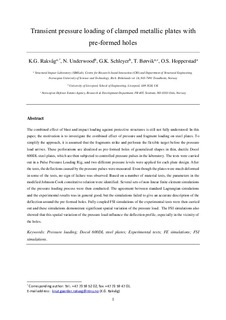| dc.contributor.author | Rakvåg, Knut Gaarder | |
| dc.contributor.author | Underwood, NJ | |
| dc.contributor.author | Schleyer, GK | |
| dc.contributor.author | Børvik, Tore | |
| dc.contributor.author | Hopperstad, Odd Sture | |
| dc.date.accessioned | 2017-11-03T13:30:32Z | |
| dc.date.available | 2017-11-03T13:30:32Z | |
| dc.date.created | 2013-03-15T11:12:55Z | |
| dc.date.issued | 2013 | |
| dc.identifier.citation | International Journal of Impact Engineering. 2013, 53 44-55. | nb_NO |
| dc.identifier.issn | 0734-743X | |
| dc.identifier.uri | http://hdl.handle.net/11250/2464025 | |
| dc.description.abstract | The combined effect of blast and impact loading against protective structures is still not fully understood. In this paper, the motivation is to investigate the combined effect of pressure and fragment loading on steel plates. To simplify the approach, it is assumed that the fragments strike and perforate the flexible target before the pressure load arrives. These perforations are idealized as pre-formed holes of generalized shapes in thin, ductile Docol 600DL steel plates, which are then subjected to controlled pressure pulses in the laboratory. The tests were carried out in a Pulse Pressure Loading Rig, and two different pressure levels were applied for each plate design. After the tests, the deflections caused by the pressure pulses were measured. Even though the plates were much deformed in some of the tests, no sign of failure was observed. Based on a number of material tests, the parameters in the modified Johnson–Cook constitutive relation were identified. Several sets of non-linear finite element simulations of the pressure loading process were then conducted. The agreement between standard Lagrangian simulations and the experimental results was in general good, but the simulations failed to give an accurate description of the deflection around the pre-formed holes. Fully coupled FSI simulations of the experimental tests were then carried out and these simulations demonstrate significant spatial variation of the pressure load. The FSI simulations also showed that this spatial variation of the pressure load influence the deflection profile, especially in the vicinity of the holes. | nb_NO |
| dc.language.iso | eng | nb_NO |
| dc.publisher | Elsevier | nb_NO |
| dc.rights | Attribution-NonCommercial-NoDerivatives 4.0 Internasjonal | * |
| dc.rights.uri | http://creativecommons.org/licenses/by-nc-nd/4.0/deed.no | * |
| dc.title | Transient pressure loading of clamped metallic plates with pre-formed holes | nb_NO |
| dc.type | Journal article | nb_NO |
| dc.type | Peer reviewed | nb_NO |
| dc.description.version | acceptedVersion | nb_NO |
| dc.source.pagenumber | 44-55 | nb_NO |
| dc.source.volume | 53 | nb_NO |
| dc.source.journal | International Journal of Impact Engineering | nb_NO |
| dc.identifier.doi | 10.1016/j.ijimpeng.2012.07.013 | |
| dc.identifier.cristin | 1019449 | |
| dc.relation.project | Norges forskningsråd: 174834 | nb_NO |
| dc.description.localcode | © 2012. This is the authors’ accepted and refereed manuscript to the article. This manuscript version is made available under the CC-BY-NC-ND 4.0 license http://creativecommons.org/licenses/by-nc-nd/4.0/ | nb_NO |
| cristin.unitcode | 194,64,45,0 | |
| cristin.unitname | Institutt for konstruksjonsteknikk | |
| cristin.ispublished | true | |
| cristin.fulltext | postprint | |
| cristin.qualitycode | 2 | |

